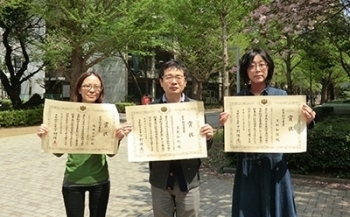UTokyo Faculty Members Receive AY 2014 MEXT Commendations for Science and Technology (Young Scientists’ Prizes)

Date of activity: April 15, 2014
Associate Professors Kazunori Ueno, Sayaka Uchida and Chisa Hotta of the Department of Basic Science in the Division of Multidisciplinary Sciences were awarded AY 2014 Commendations for Science and Technology (Young Scientists’ Prizes) by the Minister of MEXT (Ministry of Education, Culture, Sports, Science and Technology).
Each year, MEXT awards Young Scientists’ Prizes to researchers under the age of 40 who have made outstanding contributions to various scientific research areas and have demonstrated an ability to develop innovative research of a high standard.
Three professors from the Department of Basic Science in the Division of Multidisciplinary Sciences in the Graduate School of Arts and Sciences received the award this academic year:
Associate Professor Kazunori Ueno
Associate Professor Sayaka Uchida
Associate Professor Chisa Hotta
The awards ceremony took place on April 15th at the headquarters of MEXT, where the honorees received medals and certificates commending their achievements.
The press release issued by MEXT concerning the awards can be viewed here (Japanese version only):
http://www.mext.go.jp/b_menu/houdou/26/04/1346090.htm
The research achievements for which the three recipients were honored are detailed below.
Associate Professor Kazunori Ueno
Research title: “Discovery of Superconductivity by Electric Field-induced Carrier Doping”
Associate Professor Ueno developed a new superconductor from an insulator by electric field-induced carrier doping. Superconductivity is a phenomenon of zero electrical resistance in matter which takes place at low temperatures. In this field, Japanese scientific society has played a leading role. Conventionally, superconductors are chemically synthesized by alloying metallic elements or by substituting impurity atoms into a mother insulator compound, which works as a form of carrier doping. The electric field-effect, which Associate Professor Ueno newly applied here, is another method to induce charge carriers into an insulator (semiconductor) compound. The electric field-effect has been widely utilized for field-effect transistors in the semiconductor industry. However, this effect was not known to produce superconductivity, which is why he was awarded the prize.
For the purpose of material engineering, Associate Professor Ueno developed a new device by replacing the dielectric layer of a transistor with an electrolyte solution that shows ionic conduction. This enabled a large amount of carrier doping, which led to the discovery of a new superconducting material. This new scheme can be applied to many materials for which the conventional chemical method is unsuitable.
Major articles:
"Discovery of Superconductivity in KTaO3 by Electrostatic Carrier Doping." Nature Nanotechnology 6.7 (2011): 408-12.
"Electric Field-induced Superconductivity in an Insulator." Nature Materials 7.11 (2008): 855-58.
Associate Professor Sayaka Uchida
Research title: “Hierarchical Synthesis of Porous Ionic Crystals and their Functions”
Associate Professor Uchida has successfully developed a systematic way of synthesizing multi-functional porous ionic crystals. Crystalline porous materials can absorb gases, separate mixtures, or be used as ion exchangers and catalysts, and are thus a target of a wide range of research from basic to applied science. Their synthesis, however, had been more or less based on semiempirical techniques, and developing systematic methodology for this process has long been a big challenge in material chemistry.
Associate Professor Uchida focused on ionic crystals, which are characterized by their dense structure, and succeeded in synthesizing crystalline porous media through three different processes: synthesizing units (composite ions), combining them into ionic crystals, and controlling their shape.
This finding will enable the separation and refinement of carbon dioxide and lower hydrocarbon, which are indispensable for the future of the chemical industry and the alleviation of environmental problems.
Major articles:
"Zeotype Organic-Inorganic Ionic Crystals: Facile Cation Exchange and Controllable Sorption Properties." Angewandte Chemie International Edition 49.51 (2010): 9930-934.
"Highly Selective Sorption of Small Unsaturated Hydrocarbons by Nonporous Flexible Framework with Silver Ion." Journal of the American Chemical Society 130.37 (2008): 12370-2376.
Associate Professor Chisa Hotta
Research title: “Theoretical Research on Irregular Quantum Phases of a Strongly Correlated, Frustrated System”
Associate Professor Hotta contributed theoretically to the discovery of unconventional phases of matter in strongly correlated systems. Quantum many-body systems, particularly strongly correlated and frustrated systems, are classes difficult to handle from a theoretical standpoint. One of the main challenging issues in this field has been the discovery of a spin liquid – a phase that escapes from any kind of conventional long-range ordering down to the lowest temperature – while even the standard models of geometrically frustrated magnets based on the triangular and kagome lattices are still far from being solved.
Associate Professor Hotta has promoted research aspiring to find new phases of matter in such correlated systems. She has proposed several new phases and concepts, such as anomalous metals induced by the charge frustration and multiferroics based on quantum electric dipoles. She also contributed to the numerical method called “grand canonical analysis,” which led to the collaboration discovering a new class of spin liquid in a kagome antiferromagnet in an applied field.
These findings bring new insight into the area of numerical study on many-body systems and are expected to stimulate experimental studies in this field.
Major articles:
“Quantum Electric Dipoles in Spin-liquid Dimer Mott Insulator k-ET2Cu2(CN)3." Physical Review B 82.24 (2010).
"Grand Canonical Finite-size Numerical Approaches: A Route to Measuring Bulk Properties in an Applied Field." Physical Review B 86.4 (2012).







